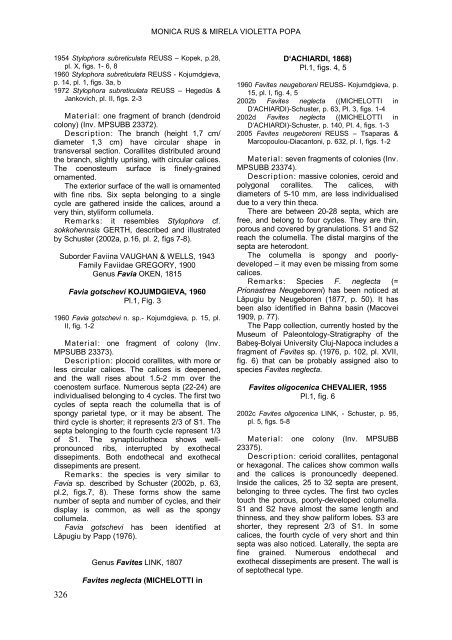taxonomic notes on the badenian corals from lăpugiu de sus
taxonomic notes on the badenian corals from lăpugiu de sus
taxonomic notes on the badenian corals from lăpugiu de sus
Create successful ePaper yourself
Turn your PDF publications into a flip-book with our unique Google optimized e-Paper software.
MONICA RUS & MIRELA VIOLETTA POPA<br />
1954 Stylophora subreticulata REUSS – Kopek, p.28,<br />
pl. X, figs. 1- 6, 8<br />
1960 Stylophora subreticulata REUSS - Kojumdgieva,<br />
p. 14, pl. 1, figs. 3a, b<br />
1972 Stylophora subreticulata REUSS – Hegedüs &<br />
Jankovich, pl. II, figs. 2-3<br />
Material: <strong>on</strong>e fragment of branch (<strong>de</strong>ndroid<br />
col<strong>on</strong>y) (Inv. MPSUBB 23372).<br />
Descripti<strong>on</strong>: The branch (height 1,7 cm/<br />
diameter 1,3 cm) have circular shape in<br />
transversal secti<strong>on</strong>. Corallites distributed around<br />
<strong>the</strong> branch, slightly uprising, with circular calices.<br />
The coenosteum surface is finely-grained<br />
ornamented.<br />
The exterior surface of <strong>the</strong> wall is ornamented<br />
with fine ribs. Six septa bel<strong>on</strong>ging to a single<br />
cycle are ga<strong>the</strong>red insi<strong>de</strong> <strong>the</strong> calices, around a<br />
very thin, styliform collumela.<br />
Remarks: it resembles Stylophora cf.<br />
sokkohennsis GERTH, <strong>de</strong>scribed and illustrated<br />
by Schuster (2002a, p.16, pl. 2, figs 7-8).<br />
Subor<strong>de</strong>r Faviina VAUGHAN & WELLS, 1943<br />
Family Faviidae GREGORY, 1900<br />
Genus Favia OKEN, 1815<br />
326<br />
Favia gotschevi KOJUMDGIEVA, 1960<br />
Pl.1, Fig. 3<br />
1960 Favia gotschevi n. sp.- Kojumdgieva, p. 15, pl.<br />
II, fig. 1-2<br />
Material: <strong>on</strong>e fragment of col<strong>on</strong>y (Inv.<br />
MPSUBB 23373).<br />
Descripti<strong>on</strong>: plocoid corallites, with more or<br />
less circular calices. The calices is <strong>de</strong>epened,<br />
and <strong>the</strong> wall rises about 1.5-2 mm over <strong>the</strong><br />
coenostem surface. Numerous septa (22-24) are<br />
individualised bel<strong>on</strong>ging to 4 cycles. The first two<br />
cycles of septa reach <strong>the</strong> columella that is of<br />
sp<strong>on</strong>gy parietal type, or it may be absent. The<br />
third cycle is shorter; it represents 2/3 of S1. The<br />
septa bel<strong>on</strong>ging to <strong>the</strong> fourth cycle represent 1/3<br />
of S1. The synapticulo<strong>the</strong>ca shows wellpr<strong>on</strong>ounced<br />
ribs, interrupted by exo<strong>the</strong>cal<br />
dissepiments. Both endo<strong>the</strong>cal and exo<strong>the</strong>cal<br />
dissepiments are present.<br />
Remarks: <strong>the</strong> species is very similar to<br />
Favia sp. <strong>de</strong>scribed by Schuster (2002b, p. 63,<br />
pl.2, figs.7, 8). These forms show <strong>the</strong> same<br />
number of septa and number of cycles, and <strong>the</strong>ir<br />
display is comm<strong>on</strong>, as well as <strong>the</strong> sp<strong>on</strong>gy<br />
collumela.<br />
Favia gotschevi has been i<strong>de</strong>ntified at<br />
Lăpugiu by Papp (1976).<br />
Genus Favites LINK, 1807<br />
Favites neglecta (MICHELOTTI in<br />
D‘ACHIARDI, 1868)<br />
Pl.1, figs. 4, 5<br />
1960 Favites neugeboreni REUSS- Kojumdgieva, p.<br />
15, pl. I, fig. 4, 5<br />
2002b Favites neglecta ((MICHELOTTI in<br />
D‘ACHIARDI)-Schuster, p. 63, Pl. 3, figs. 1-4<br />
2002d Favites neglecta ((MICHELOTTI in<br />
D‘ACHIARDI)-Schuster, p. 140, Pl. 4, figs. 1-3<br />
2005 Favites neugeboreni REUSS – Tsaparas &<br />
Marcopoulou-Diacant<strong>on</strong>i, p. 632, pl. I, figs. 1-2<br />
Material: seven fragments of col<strong>on</strong>ies (Inv.<br />
MPSUBB 23374).<br />
Descripti<strong>on</strong>: massive col<strong>on</strong>ies, ceroid and<br />
polyg<strong>on</strong>al corallites. The calices, with<br />
diameters of 5-10 mm, are less individualised<br />
due to a very thin <strong>the</strong>ca.<br />
There are between 20-28 septa, which are<br />
free, and bel<strong>on</strong>g to four cycles. They are thin,<br />
porous and covered by granulati<strong>on</strong>s. S1 and S2<br />
reach <strong>the</strong> columella. The distal margins of <strong>the</strong><br />
septa are heterod<strong>on</strong>t.<br />
The columella is sp<strong>on</strong>gy and poorly<strong>de</strong>veloped<br />
– it may even be missing <strong>from</strong> some<br />
calices.<br />
Remarks: Species F. neglecta (=<br />
Pri<strong>on</strong>astrea Neugeboreni) has been noticed at<br />
Lăpugiu by Neugeboren (1877, p. 50). It has<br />
been also i<strong>de</strong>ntified in Bahna basin (Macovei<br />
1909, p. 77).<br />
The Papp collecti<strong>on</strong>, currently hosted by <strong>the</strong><br />
Museum of Pale<strong>on</strong>tology-Stratigraphy of <strong>the</strong><br />
Babeş-Bolyai University Cluj-Napoca inclu<strong>de</strong>s a<br />
fragment of Favites sp. (1976, p. 102, pl. XVII,<br />
fig. 6) that can be probably assigned also to<br />
species Favites neglecta.<br />
Favites oligocenica CHEVALIER, 1955<br />
Pl.1, fig. 6<br />
2002c Favites oligocenica LINK, - Schuster, p. 95,<br />
pl. 5, figs. 5-8<br />
Material: <strong>on</strong>e col<strong>on</strong>y (Inv. MPSUBB<br />
23375).<br />
Descripti<strong>on</strong>: cerioid corallites, pentag<strong>on</strong>al<br />
or hexag<strong>on</strong>al. The calices show comm<strong>on</strong> walls<br />
and <strong>the</strong> calices is pr<strong>on</strong>ouncedly <strong>de</strong>epened.<br />
Insi<strong>de</strong> <strong>the</strong> calices, 25 to 32 septa are present,<br />
bel<strong>on</strong>ging to three cycles. The first two cycles<br />
touch <strong>the</strong> porous, poorly-<strong>de</strong>veloped columella.<br />
S1 and S2 have almost <strong>the</strong> same length and<br />
thinness, and <strong>the</strong>y show paliform lobes. S3 are<br />
shorter, <strong>the</strong>y represent 2/3 of S1. In some<br />
calices, <strong>the</strong> fourth cycle of very short and thin<br />
septa was also noticed. Laterally, <strong>the</strong> septa are<br />
fine grained. Numerous endo<strong>the</strong>cal and<br />
exo<strong>the</strong>cal dissepiments are present. The wall is<br />
of septo<strong>the</strong>cal type.

















